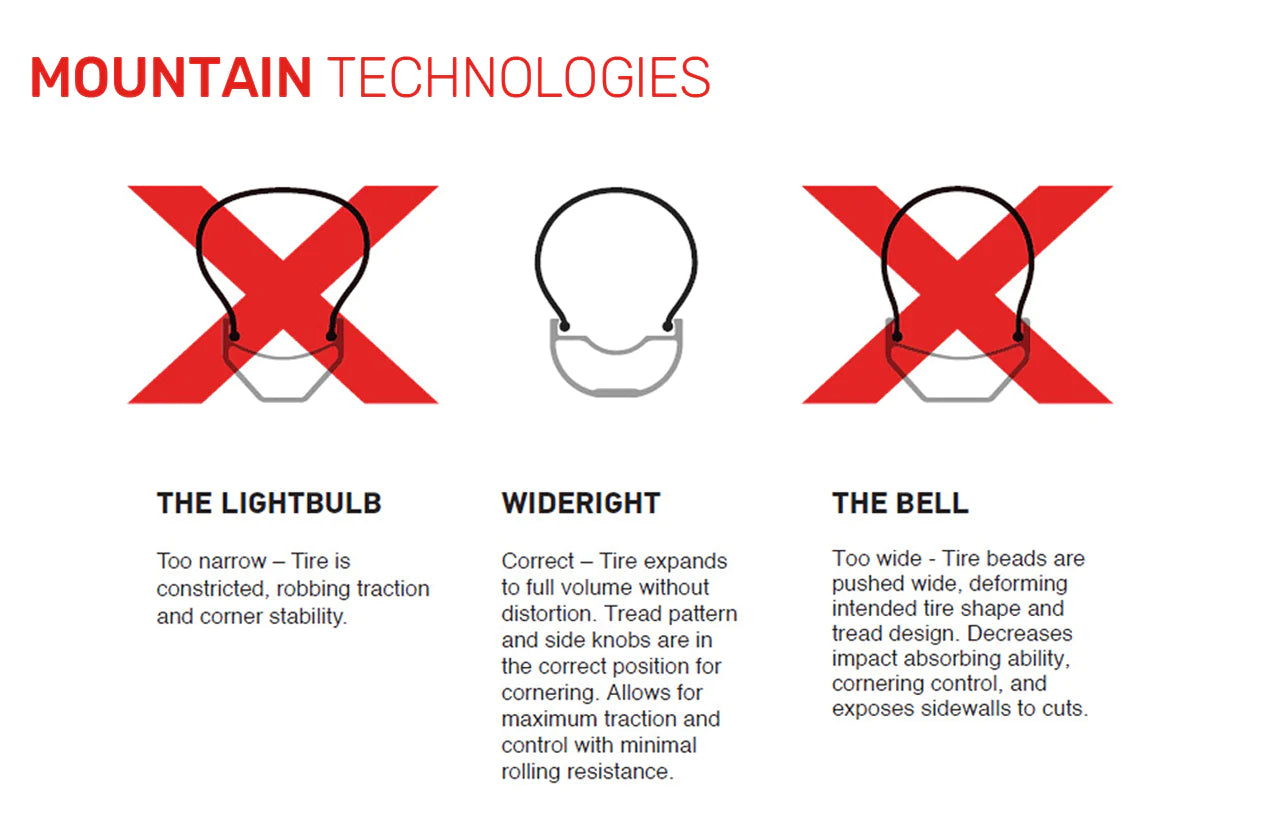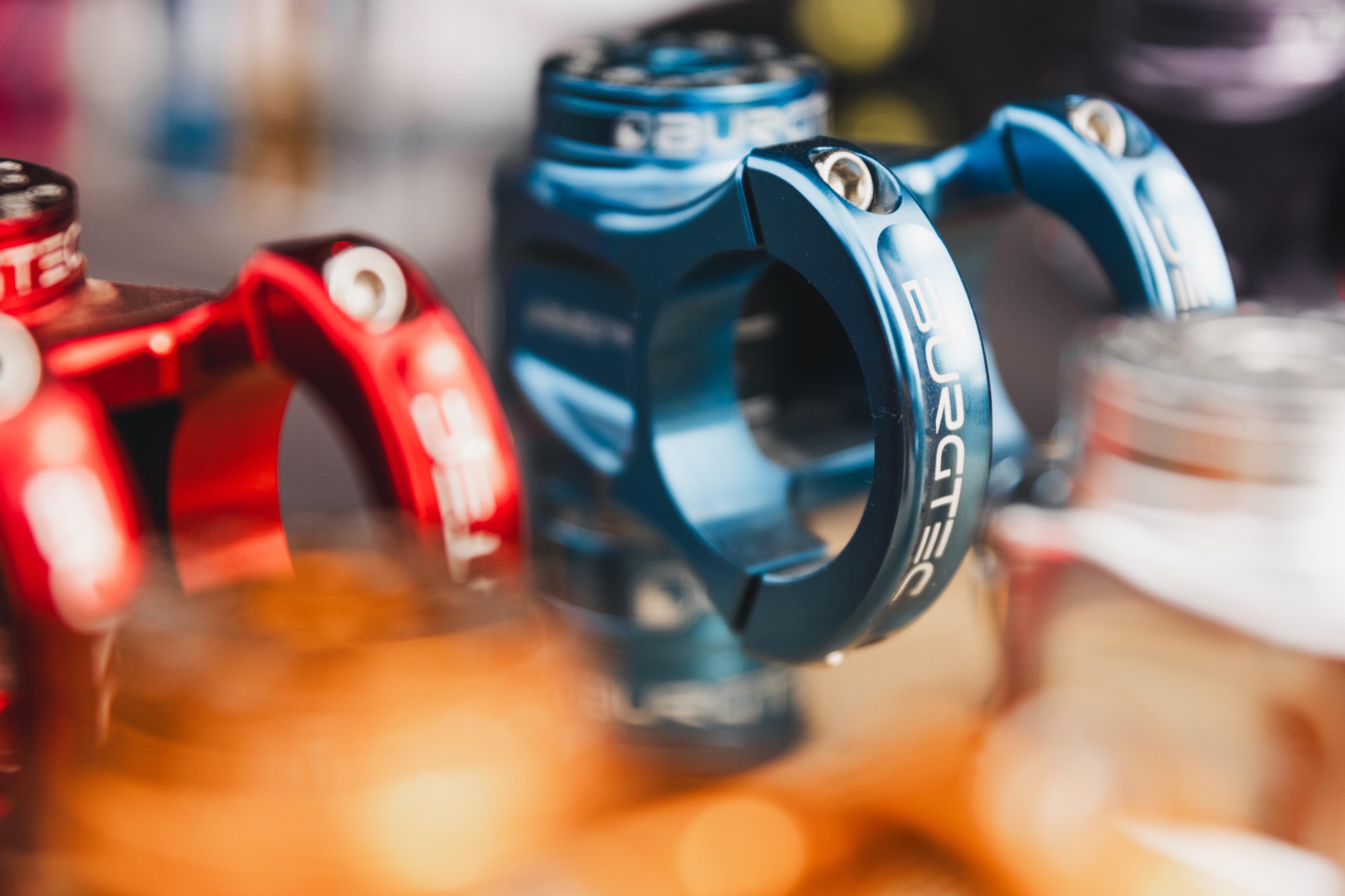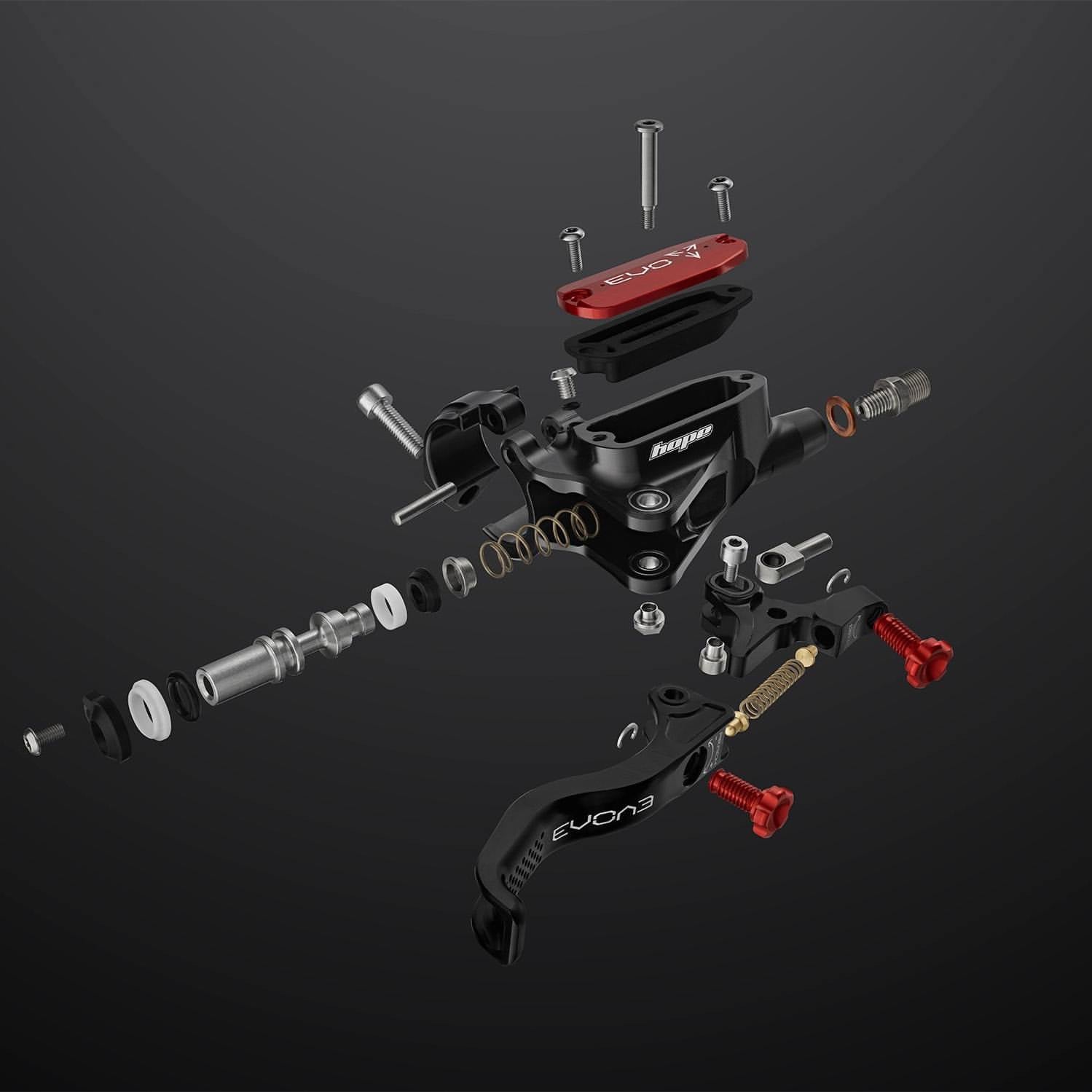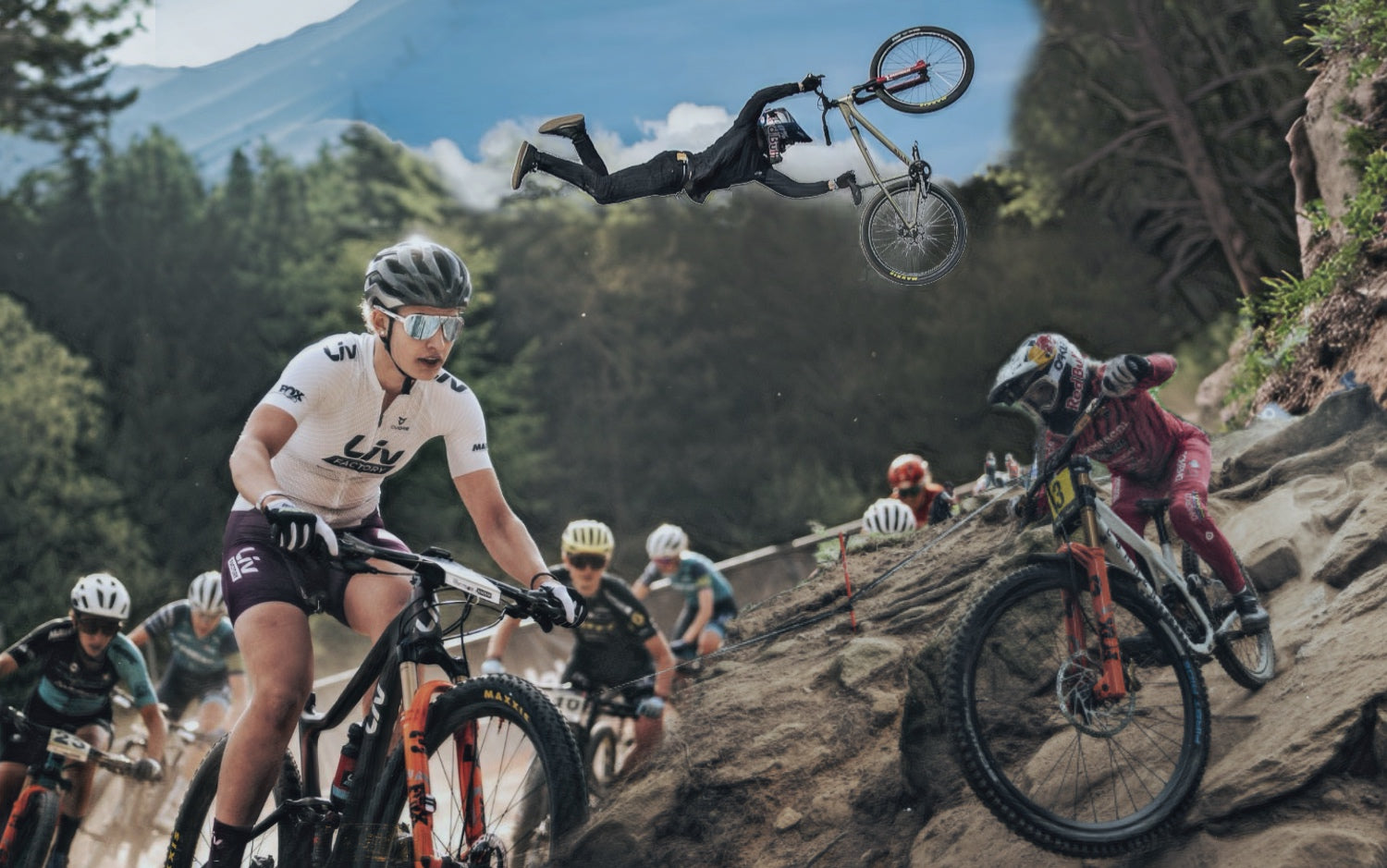The Art of Traction: An MTB Tyre Guide
Welcome
Welcome to our MTB tyre guide! We know how confusing mountain bike tyres can be. Well, we do live amongst them and advise customers daily on the right tyres. We're here to maximize your biking experience, starting from the ground up, literally. That's why we've put together this mountain
bike tyre guide, your go-to resource for mastering the terrain.
Whether you're eyeing those gnarly trails or cruising through scenic routes, the right tyres can make all the difference. Sick of slashing those tyres like Michael Myers, keep on reading.
In this guide, we'll break down everything you need to know about tyre sizing, tread patterns, compounds, and more—so you can confidently choose the perfect set for your riding style and terrain.
Finding Your Current Tyre Size: A Quick Guide
Before you start selecting new tyres for your mountain bike, it's essential to know the size of your current tyres. Here's a quick guide to help you find your current tyre size:
- Check the Sidewall: The easiest way to determine your tyre size is to look at the sidewall of your current tyre. You'll typically find a series of numbers and letters printed on the sidewall, indicating the tyre's size and other specifications like the direction the tyre must be fitted.
- Decode the Numbers: The tyre size is typically expressed in a format like 27.5"x2.4" or 29"x2.2". The first number represents the diameter of the tyre in inches, while the second number denotes the width of the tyre in inches. For example, a tyre marked 27.5"x2.4" indicates a tyre/Wheel with a diameter of 27.5 inches and a width of 2.4 inches.
- Note the Compatibility: It's essential to ensure that any new tyres you purchase are compatible with your bike's rims and frame. Pay attention to factors such as tyre diameter, width, and clearance to avoid any fitment issues. Front tyres generally have more clearance than the rear.

By following these simple steps, you can quickly identify the size of your current tyres which will help when selecting replacements or upgrades.
Essential Considerations When Purchasing Mountain Bike Tyres
Front and Rear Specific Tyres
Mountain bike tyres are often designed with specific roles in mind, with some models optimized for front-wheel use and others for the rear. Understanding the differences between front and rear tyres can help you maximize traction, control, and overall performance on the trails.
- Front Tyres: Front-specific tyres typically feature aggressive tread patterns with larger knobs on the shoulder for enhanced cornering grip and control. These tyres prioritize traction and stability, making them well-suited to technical descents and challenging terrain.
- Rear Tyres: Rear-specific tyres often have a more balanced tread pattern with smaller knobs across the entire surface for efficient pedaling and acceleration. These tyres focus on minimizing rolling resistance while providing adequate traction and braking performance, particularly on climbs and flat sections.
Front Tyre Features
When selecting a front tyre for your mountain bike, consider the following features to ensure optimal performance:
- Aggressive Tread Pattern: Look for a tyre with an aggressive tread pattern featuring large, well-spaced knobs on the shoulder for maximum traction and cornering grip.
- Wide Profile: A wider tyre profile can provide added stability and confidence on technical descents, especially in loose or muddy conditions.
- Tubeless Compatibility: Tubeless-ready tyres allow you to run lower tyre pressures for increased traction and control without the risk of pinch flats.
This is what Continental have to say about their front specific tyre -
KRYPTOTAL Fr - Pattern design especially tailored for front wheel use. Benefit: best performance in front wheel specific requirements like track stability, agility. Designed with the same design boundary conditions as KRYPTOTAL Re: steep and shallow ramps tailored to the area of application in mixed and loose terrain. Benefit: balance between harmonious, easy rolling and power transmission.
Rear Tyre Features
When choosing a rear tyre for your mountain bike, focus on features that prioritize efficiency, traction, and durability:
- Balanced Tread Pattern: Opt for a tyre with a balanced tread pattern that balances traction and rolling efficiency, with smaller knobs for efficient pedaling and braking performance.
- Durable Construction: Look for a tyre with a robust casing and reinforced sidewalls to withstand impacts and abrasions, particularly in rocky terrain.
- Tubeless Compatibility: Like front tyres, rear tyres benefit from tubeless compatibility, allowing for lower tyre pressures and enhanced traction without sacrificing puncture protection.
This is what Continental have to say about their rear specific tyre -
KRYPTOTAL Re - Pattern design especially tailored for rear wheel use. Benefit: best performance in rear wheel specific requirements like braking, traction and track stability. Balance of positive profile and open areas designed for best performance in complex terrains. Benefit: sweet spot between grip, self-cleaning, adaptivity and rolling characteristics. The use of steep and shallow ramps are tailored to the area of application in mixed and loose terrain. Benefit: balance between harmonious, easy rolling and power transmission
By considering these essential factors and selecting front and rear tyres tailored to your riding style and terrain preferences, you can tackle the trails with confidence and control.
Mountain Bike Tyre Sizes:
Selecting the right tyre size is crucial, otherwise you and your wallet are going to be pretty upset. Let's delve into the world of mountain bike tyre sizes to help you get it right first time:
Exploring Common Mountain Bike Tyre Sizes
Mountain bike tyre sizes vary widely, catering to different riding styles, terrains, and preferences. Here are some common tyre sizes you're likely to see:
- 26-inch: Historically the standard size for mountain bikes, 26-inch tyres offer nimble handling and agility. While less common on newer models, they are still prevalent, particularly in certain disciplines like freeride and dirt jumping. With many freeride guys currently running 27.5 up front and 26 at the rear.
- 27.5-inch (650b): This intermediate size combines the agility of 26-inch tyres with the improved rolling efficiency and stability of larger sizes.
27.5-inch tyres have gained popularity across various riding disciplines due to their versatility. Many now choosing to ride a mullet set up - 29” at the front for the rollover capability, with a 27.5” at the rear for agility when cornering or riding steep terrain. - 29-inch (29er): Known for their enhanced rollover capability and stability, 29-inch wheels are favoured by many riders, especially those tackling rough terrain and long-distance trails. They offer improved traction and smoother ride quality over obstacles. Higher speeds are possible with larger wheels but at the detriment of acceleration. They are less nimble than smaller size wheels, so choose your wheel size according to your riding style.
- Plus-size (27.5+ and 29+): Typically 2.8 - 3.0” wide. Plus-size tyres feature wider casings and increased volume, providing additional traction, comfort, and flotation over rough terrain. They excel in challenging conditions like loose gravel, mud, and snow, offering enhanced control and confidence. Plus size bikes have taken a bit of a back seat in recent years. They lost popularity and now are rerely seen on new models.
- Fat bike: Fat bike tyres are exceptionally wide, typically ranging from 3.8 to 5 inches or more in width. Designed for riding on soft, loose surfaces like sand and snow, fat bike tyres offer amazing traction and stability in extreme conditions.
Each tyre size has it's advantages and considerations, depending on your riding style, terrain and personal preferences. By understanding the characteristics of common mountain bike tyre sizes, you can select the size that best suits your needs.
What Factors Determine the Size of a Bicycle Tyre?
When it comes to selecting the right size for your bike, several key factors come into play. Let's break them down:
Exploring ETRTO Tyre Sizing: What You Need to Know - ETRTO (European Tire and Rim Technical Organization) tyre sizing is a standardized system used to specify the dimensions of bicycle tyres and rims.
It consists of a series of numbers typically found on the sidewall of the tyre, such as 29x2.6" or 27.5x2.4". The first number indicates the tyre's diameter in inches, while the second number represents the tyre's width in inches.
Understanding this system can help ensure compatibility between your tyres and rims.

Deciphering Tyre Width: Remember from the last section, the second number on the tyre represents the width of the tyre.
What Does it Indicate?
Tyre width plays a significant role in determining the tyre's performance characteristics, including traction, stability, and rolling resistance.
Wider tyres generally offer more grip and stability, particularly in off-road conditions, while narrower tyres are often favoured for smoother, faster rides on hard pack or smooth trails.
The Impact of Rim Width on Tyre Size
Let's explore how rim width influences tyre size and performance:
Rim width directly affects the shape and profile of the tyre when mounted, which in turn impacts its contact patch, sidewall support, and overall performance characteristics.
Here's how different rim widths can affect tyre size:
- Narrow rims: When paired with narrow rims, tyres tend to have a more rounded profile. This can result in reduced stability and cornering traction, as well as increased susceptibility to pinch flats when running lower pressures. However, narrower rims may offer slightly lower rolling resistance on smoother surfaces
- Wide rims: Wide rims create a broader, flatter tyre profile, which can improve cornering stability, traction and sidewall support. Additionally, wider rims allow for lower tyre pressures without sacrificing sidewall stability, enhancing grip and comfort over rough terrain. However, excessively wide rims may lead to tyre "squirm" and reduced efficiency on hard-packed surfaces.
- Consider riding style and terrain: Riders tackling aggressive trails or technical terrain may prefer wider rims for improved stability and traction, while those focusing on speed and efficiency might opt for narrower rims for reduced weight and rolling resistance.
You should now be able to select rims and tyres that complement each other and match the terrain you ride the most. Some people will change tyres dependant on where they are riding. But rims are something you cant change so easily.

This is a great infographic from Stans No Tubes showing the impact of different size rims
Understanding Tread Patterns: What They Signify
The tread pattern on a mountain bike tyre isn't just about looks - it's a carefully engineered design that serves specific functions across different riding conditions. Here's a closer look at tread patterns and their purposes:

Centre Treads:
The centre treads are responsible for providing traction and stability on straight-line surfaces and during pedaling.
These typically feature smaller, closely spaced knobs or a smoother surface to reduce rolling resistance and enhance efficiency on hard-packed or smooth terrain.

Side Knobs:
Side knobs are essential for cornering grip and stability, especially when leaning the bike into turns.
These larger, more aggressive knobs are strategically positioned on the edges of the tyre to bite into the ground and provide traction during cornering, ensuring control and confidence on off-camber or loose surfaces.

Transition Knobs:
Transition knobs bridge the gap between the centre treads and side knobs, facilitating smooth and predictable transitions during cornering.
Positioned between the centre and side knobs, transition knobs offer a balance of traction and stability, helping the tyre maintain grip as it shifts from straight-line riding to cornering and back again.

Siping
Cuts and grooves, akin to large sipes, play a crucial role in enhancing traction and maneuverability. These features, also known as siping, create additional edges on tyre lugs, improving grip on various surfaces.
Improved Flexibility: Enhances the tyre's flexibility, aiding in braking, turning, and accelerating. This allows for fine-tuning tyre dynamics to suit specific requirements.
Spacing and Shape:
The spacing and shape of the knobs directly influence the tyre's grip, rolling resistance, and self-cleaning properties.
Widely spaced knobs allow mud and debris to shed easily, preventing buildup and maintaining traction in muddy or loose conditions. Meanwhile, square-shaped knobs provide more biting edges for enhanced traction, while rounded knobs offer smoother transitions and reduced rolling resistance.
Understanding how each component of the tread pattern contributes to traction, stability, and performance can help you choose tyres that are best suited to your riding style.
Whether you're navigating technical descents or powering through fast corners, the right tread pattern can make all the difference to your riding.
Decoding Mountain Bike Tyre Compounds
Mountain bike tyre compounds play a significant role in determining traction, durability, and rolling efficiency. But their not always the easiest to understand, every brand has different names for their compounds like 3C, Black Chilli, Addix to name but a few. Rest assured we will do a blog covering the big brands compounds and how they fair against each other.
Let's delve into the key aspects of tyre compounds and what they mean for your riding.
Rubber Composition:
The composition of the rubber compound influences grip, longevity, and rolling resistance.
Soft compounds offer superior traction by conforming to irregularities in the trail surface, providing maximum grip in a variety of conditions. However, they tend to wear out quicker.
Conversely, harder compounds offer increased durability and lower rolling resistance but may sacrifice some traction, particularly in loose/rocky terrain.
Dual-Compound Designs:
Again many Dual-compound tyre designs have multiple different names dependant on the brand. In theory they all combine different rubber compounds to optimize grip and longevity.
Some will use a harder compound in the centre tread for reduced rolling resistance and a softer compound on the side knobs for enhanced cornering grip. Some will use a harder compound layer at the base of the tyre with the tread being a softer material for grip, dual-compound tyres can offer the best of both worlds.
This results in improved overall performance, particularly on trails with a mix of straight-line sections and technical features.

This is an example of Maxxis's Maxxterra compound

This is an example of Maxxis' Maxxgrip compound.
Terrain and Riding Style Considerations:
Choosing the right tyre compound depends on your preferred riding style and the terrain you encounter most frequently.
Riders tackling technical trails with steep descents and loose surfaces may prioritize grip and traction over durability, opting for softer compounds like the dual compound designed tyres.
Meanwhile, riders focusing on cross-country or endurance riding may prioritize durability and efficiency, favouring harder compounds for reduced rolling resistance and longer lifespan.
By understanding the nuances of mountain bike tyre compounds, you can make informed decisions when selecting tyres that best suit your riding style, and performance requirements.
Whether you're shredding down techy descents or grinding out miles on smooth trails, the right tyre compound will change your riding.
To Tubeless or Not to Tubeless
The debate between tubeless and traditional inner tube setups has been a hot topic among mountain bikers since its inception. We often get asked is it worth it?
Let's weigh the pros and cons of each to help you decide which option is best for you:

Tubeless Setup:
Pros:
- Reduced Risk of Punctures: Tubeless tyres eliminate the need for inner tubes, significantly reducing the risk of pinch flats and punctures caused by thorns, rocks, and other trail debris.
- Lower Rolling Resistance: Without the friction and weight of inner tubes, tubeless tyres typically roll faster and more efficiently, offering a smoother and more responsive ride.
- Improved Traction and Control: Tubeless setups allow riders to run lower tyre pressures for increased traction and control, particularly in challenging terrain or when cornering aggressively.
- Sealant Seals Punctures: The sealant inside tubeless tyres can quickly and effectively seal small punctures as they occur, allowing you to continue riding without significant loss of air pressure.
Cons:
- Initial Setup Can Be Tricky: Setting up tubeless tyres can be more involved and time-consuming than installing traditional inner tubes, requiring special tubeless-ready rims, tyre sealant, and compatible tyres.
- Sealant Maintenance: Tubeless tyres require periodic inspection and replenishment of sealant to maintain their puncture-sealing capabilities.
Sealant can dry out over time and may need to be replaced every few months.
Traditional Inner Tube Setup:
Pros:
- Simplicity and Familiarity: Traditional inner tube setups are straightforward to install and maintain, requiring minimal equipment and expertise.
- Lower Initial Cost: Inner tubes are typically less expensive than tubeless setups, making them a more budget-friendly option for riders on a tight budget.
- Quick and Easy Repairs: In the event of a puncture, repairing or replacing an inner tube is usually a quicker and simpler process than dealing with a tubeless setup.
Cons:
- Increased Risk of Punctures: Inner tubes are more susceptible to pinch flats and punctures from trail hazards, potentially leading to more frequent stops and repairs during rides.
- Higher Rolling Resistance: The friction and weight of inner tubes can result in higher rolling resistance compared to tubeless setups, affecting overall speed and efficiency on the trail.
- Limited Traction and Control: Running higher tyre pressures to reduce the risk of pinch flats can compromise traction and control, particularly in technical terrain or when riding aggressively.
Ultimately, the decision to go tubeless or stick with traditional inner tubes depends on your priorities, preferences, and riding conditions.
Whether you opt for the simplicity of inner tubes or the performance benefits of tubeless technology, both setups have their merits and can enhance your experience in different ways.
Mountain Bike Tyre Protection Levels
Protecting your tyres from punctures and cuts is essential for maintaining performance and minimizing downtime on the trails. No one wants to be carrying their bike home, especially when you're in the middle of nowhere.
Again a difficult one to explain since every brand has a different name and design of carcass, from Continentals Trail, Enduro, Downhill casing to maxxis' Exo, Exo+ and DD casing. I will write a blog in detail compairing the different carcass design. So keep your eye out for that.
Let's explore the different levels of tyre protection available and their respective benefits:

Image taken from Continental showing the trail carcass construction
Standard Casing:
Standard casing tyres feature a basic construction with a single layer of casing material, providing minimal protection against punctures and cuts.
These tyres are lightweight and affordable, making them a popular choice for riders who prioritize weight savings and cost-effectiveness.

Image taken from Continental showing the enduro carcass construction
Reinforced Casing:
Reinforced casing tyres incorporate additional layers of puncture-resistant material, such as aramid fibers or reinforced sidewalls, to enhance durability and puncture resistance.
Reinforced casing tyres offer improved protection against punctures and cuts without significant increases in weight. They're suitable for riders seeking a balance between performance and durability in challenging terrain.

Image taken from Continental showing the Downhill carcass construction
Gravity/DH Casing:
Gravity or downhill casing tyres are specifically designed for aggressive riding styles and demanding terrain, featuring robust casings with extra layers of reinforcement.
These tyres offer maximum puncture protection and durability, making them ideal for downhill racing, freeride, and enduro disciplines where impacts and abrasions are common. However, they may be heavier and less responsive than other tyre options.
On top of the carcass, other ways to protect from puncures can be setting up tubeless and using inserts. lets look at these two options below.
Tubeless Ready (TLR):
Tubeless ready tyres are designed to be used with a tubeless setup, featuring air-tight casings and sidewalls that seal tightly against the rim without the need for inner tubes.
Tubeless ready tyres provide superior puncture protection compared to standard inner tubes. The sealant inside the tyre can quickly seal small punctures as they occur, reducing the risk of flats and allowing for lower tyre pressures and enhanced traction.
Anti-Puncture Inserts:
Anti-puncture inserts are aftermarket products designed to provide additional protection for tyres against punctures and pinch flats. These inserts are placed inside the tyre between the casing and the tread. Generally these are avaialable for tubeless set-ups only.
Anti-puncture inserts offer an extra layer of defence against sharp objects and impacts, reducing the likelihood of punctures and enhancing overall tyre durability. They're a popular choice for riders seeking added peace of mind in rough terrain.
Choosing the right level of tyre protection depends on your riding style, terrain preferences, and tolerance for punctures and downtime. Whether you're racing downhill, exploring technical trails, or enjoying leisurely rides, selecting tyres with the appropriate level of protection can help you ride with confidence and peace of mind.
The Impact of Weight on Tyres: Explained
The weight of your mountain bike tyres can have a significant impact on your overall riding experience, affecting factors such as rolling efficiency, traction, and handling. Let's explore how tyre weight influences performance:

Rolling Efficiency:
- Lightweight Tyres: Lighter tyres typically offer lower rolling resistance, allowing you to accelerate faster and maintain higher speeds with less effort. This can be advantageous on smooth trails and climbs where efficiency is paramount.
- Heavier Tyres: Heavier tyres may have higher rolling resistance due to increased mass and rotational inertia. While they may provide added durability and puncture resistance, they can feel sluggish and require more effort to pedal, particularly on steep climbs and extended rides.
Traction and Control:
- Lightweight Tyres: Lighter tyres may sacrifice some traction and control, especially in loose or technical terrain, as they have less mass to dig into the ground and provide grip. Riders may experience reduced cornering stability and braking performance compared to heavier tyres.
- Heavier Tyres: Heavier tyres typically offer superior traction and control, particularly in challenging conditions where grip is essential. The added weight helps the tyres maintain contact with the trail surface, providing stability and confidence-inspiring performance.
Durability and Puncture Resistance:
- Lightweight Tyres: Lightweight tyres may be more susceptible to punctures and cuts due to thinner casings and less robust construction. While they excel in terms of rolling efficiency, they may require more frequent replacements or repairs to maintain performance.
- Heavier Tyres: Heavier tyres often feature thicker casings and reinforced sidewalls, offering increased puncture resistance and durability. While they may weigh more, they can withstand rough terrain and aggressive riding styles with fewer instances of flats and damage.
Handling and Responsiveness:
- Lightweight Tyres: Lighter tyres typically provide more responsive handling, allowing for quick changes in direction and nimble maneuverability. This can be advantageous on technical trails with tight turns and obstacles that require precise control.
- Heavier Tyres: Heavier tyres may feel less responsive and agile, particularly at lower speeds, due to their increased mass. However, they may offer greater stability and predictability at higher speeds, making them well-suited to downhill descents and fast, flowing trails.
When selecting mountain bike tyres, it's essential to strike a balance between weight, performance, and durability. Whether you prioritize rolling efficiency, traction, or durability, choosing the right tyre weight can enhance your overall riding experience and confidence on the trails.
Selecting the Ideal Tyres for Your Riding Style
Trail and enduro riders encounter a variety of terrain, from technical climbs to fast descents. Here's what to look for in tyres for this riding style:
Trail and Enduro Riding
- All-Round Tread Pattern: Opt for tyres with a versatile tread pattern that balances traction, rolling efficiency, and cornering grip. A combination of smaller knobs for fast-rolling speed and larger knobs on the shoulders for cornering traction is ideal.
- Durable Construction: Choose tyres with durable casings and reinforced sidewalls to withstand the rigors of trail and enduro riding, including sharp rocks, roots, and impacts.
Downhill Riding
Downhill riders tackle steep descents, technical features, and high-speed sections that demand maximum traction and durability. Consider these features when selecting tyres for downhill riding:
- Aggressive Tread Pattern: Choose tyres with a deep and aggressive tread pattern featuring large knobs for maximum traction and control on steep descents and loose terrain.
- Wide Profile: Opt for tyres with a wide profile to provide stability and confidence at high speeds and through rough terrain.
- Heavy-Duty Construction: Look for tyres with heavy-duty casings, reinforced sidewalls, and durable rubber compounds to withstand impacts, abrasions, and sharp objects encountered on downhill courses.
Cross Country Riding
Cross country riders prioritize speed and efficiency on smooth and rolling terrain. Here are the key features to look for in tyres for cross country riding:
- Low Rolling Resistance: Select tyres with a fast-rolling tread pattern and minimal rolling resistance to maximize speed and efficiency on climbs and flat sections.
- Lightweight Construction: Opt for lightweight tyres to minimize rotational weight and improve acceleration and responsiveness.
- Traction on Climbs and Descents: While efficiency is crucial, ensure that the tyres still provide adequate traction and control on climbs, descents, and corners, particularly in loose or technical sections.
By selecting tyres tailored to your riding style—whether it's trail and enduro, cross country, or downhill—you can maximize performance, traction, and durability.
Recommended Mountain Bike Tyre Pressure
Finding the optimal tyre pressure for your mountain bike is crucial for achieving the right balance of traction, control, and comfort on the trails.
As a rule don't go over or under the manufacturers recommendation for your tyre. The recommended pressures are generally marked on the sidewall of the tyre. Tyre pressure will also be different dependant on if you run tubeless or not.
Here are some general guidelines to help you determine the recommended tyre pressure based on various factors:
Rider Weight:
- Lighter Riders: Lighter riders may benefit from lower tyre pressures, as they exert less force on the tyres and can achieve better traction and compliance with lower pressures.
- Heavier Riders: Heavier riders may require higher tyre pressures to support their weight and prevent pinch punctures, particularly on rough terrain and jumps.
Terrain Conditions:
- Loose or Soft Terrain: Lower tyre pressures provide better traction and floatation on loose or soft terrain such as mud, sand, and snow. Decreasing tyre pressure allows the tyre to conform to irregularities in the trail surface, improving grip and control.
- Hard-packed or Rocky Terrain: Higher tyre pressures offer increased stability and sidewall support on hard-packed or rocky terrain, reducing the risk of pinch flats and sidewall damage. However, excessively high pressures can result in reduced traction and a harsher ride.
Riding Style:
- Aggressive Riding: Riders who ride aggressively or tackle technical terrain may benefit from slightly lower tyre pressures to improve traction and control. Lower pressures allow the tyres to deform and conform to the trail surface, enhancing grip while cornering, braking, and descending.
- Cross Country Riding: Cross country riders may prefer slightly higher tyre pressures to maximize rolling efficiency and minimize energy loss.
Tyre Width and Volume:
- Narrow Tyres: Narrower tyres typically require higher pressures to maintain adequate sidewall support and prevent pinch flats. Higher pressures also help narrow tyres roll more efficiently on smoother surfaces.
- Wide Tyres: Wider tyres can be run at lower pressures to increase traction and comfort without sacrificing stability. Lower pressures allow wider tyres to conform to the trail surface and provide a larger contact patch for improved grip. Don't go too low though or you'll end up with the dreaded "snake bite". Then your ride is over unless you carry a spare tyre.
While these guidelines can provide a starting point for determining tyre pressure, it's essential to experiment with different pressures and adjust based on personal preference, riding style, and trail conditions.
Pay attention to factors such as tyre squirm, sidewall stability, and traction to find the optimal pressure for you. Regularly check and adjust tyre pressure before each ride to ensure its dialed exactly how you like it.
I would love to be able to give you a chart of the best tyre pressures to run, I know thats what your looking for. But unfortuntely there is no hard and fast rule for this. Trial and error is your friend in this situation, much like setting the dials on your suspension.
Final Words:
Tyres can be a minefield for sure. So many different names used for compounds and carcass constructions make it difficult to navigate. I hope with this blog we have shed a little light on what they mean to you in real world riding scenarios. If we still havent helped, let us know what we should write about in the comment section or contact us on 01977 520852. Our expert colleagues will be more than happy to answer any questions or give advice.
FAQ:
MEET THE AUTHOR
GAVIN RICHARDSON
Some say Gavin invented the wheel. They are lying of course, but he does build a mean set.
Chief of Cykel House, aging rider and father of 3. Gavin has been riding the majority of his life in multiple different forms. He created Cykel House out of passion and enthusiasm for the sport which cannot be matched.
Always on the hunt for the best products and latest trends his finger is right on the pulse.
Interesting fact - Gavin won a handwriting competition at age 7. What a legend.
Likes - A well built berm, beer and raw sprouts
Dislikes - Stainburn woods, headset cable routing and lycra






Comments